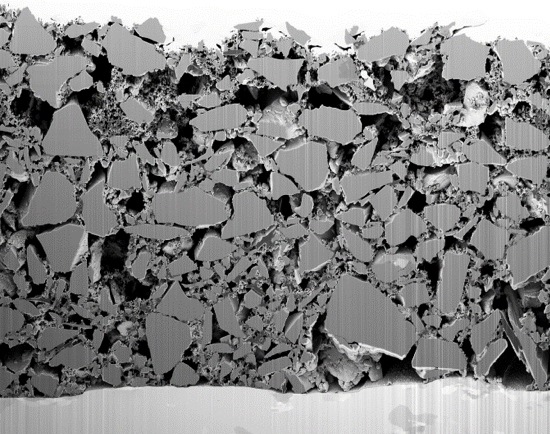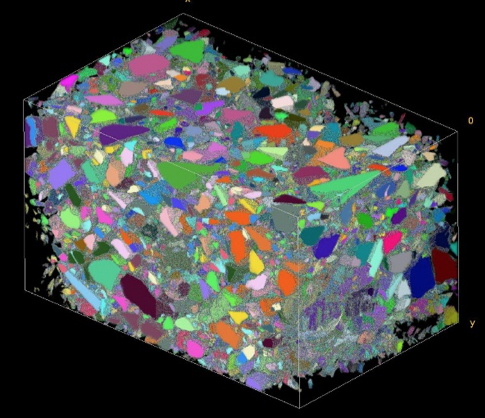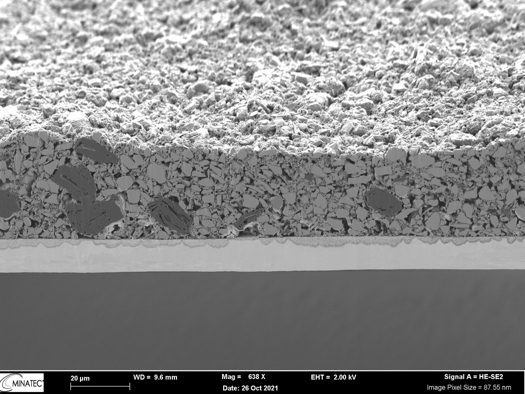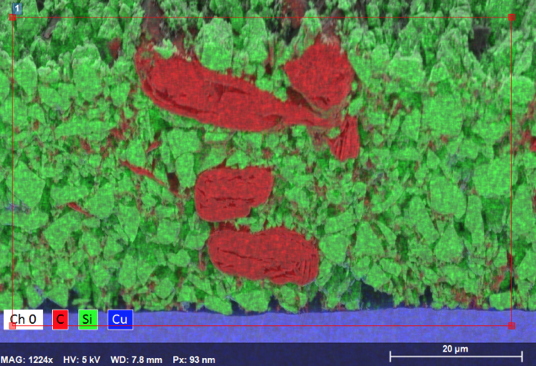 Contacts
Contacts Pierre-Henri Jouneau (FIB-SEM imaging, EDX & EELS spectroscopies)
PhD student: Patrice Perennot (in collaboration with LITEN)
The need for higher performance lithium‐ion batteries lead to considerable research effort to develop new materials, as well as to understand the reactive processes of the electrodes and the electrolyte, and their degradation during their use. These studies involve
structural and chemical characterizations at different scales, from the micrometer to the atomic scale. Our laboratory has been involved in this field for a long time with the development and use of innovative tools, notably based on FIB-SEM nanotomography (Focused ion beam scanning electron microscopy), HR-(S)TEM imaging, and EELS spectroscopy.
This work is done continuously within the framework of several major projects (e.g. the European Baccara, Sinbat and Eco2Lib projects), with the help of several PhD students and postdocs. The originality of our involvement lies in the fact that it is always carried out in close collaboration with other CEA laboratories working with a combination of complementary techniques (NMR spectroscopy, X-ray and neutron diffraction, X-ray tomography and operando analysis at ESRF), as well as those more focused on technological developments (at the LITEN institute). This positioning within complementary teams has proved successful in this field where the problems are intrinsically multi-scale, from atomic scale to the cell scale, and of various aspects (structural, chemical, electrical).
Our work mainly attempts to unravel the crystal structures and chemical evolution of electrodes and solid‐electrolyte materials, the fluctuations near interfaces, and the evolution of coexisting phases at different stages the battery life. For instance,

FIB-SEM tomography and 3D reconstructions (segmentations) make it possible to quantify the shape of active and inactive phases, SEI layers, porosity and cracks at several scales (from macro, to micro, to nano). This is done, for example, on Si-based anodes or NMC based cathodes at various cycling stages, and correlated to their performance.

Combined morphology and chemical analysis,
e.g. FIB-SEM coupled with STEM-EDX, STEM-EELS or TOF- SIMS provides key information on the elemental composition during the formation of SEI, and on the chemical redistributions during cycling. It also helps to better understand failure mechanisms and the reasons why the capacity fades.


3D volume on a pristine electrode with high Si content acquired with the Zeiss CrossBeam 550 microscope.
2450 images of 5000 x 5000 pixels, with an isometric voxel size of 12 nm.
The total volume is ~ 30 x 60 x 60 µm.


Large ion-beam cross-section (~ 200 µm) on a Si-C pristine electrode coupled with EDX analysis.
 Contact and collaborations
Contact and collaborations We are always open to new collaborations (within the time available on the instruments): if you are interested in exploring the possibility of working with us, contact us directly.
Contact:
Pierre-Henri Jouneau Recent publications[1]
Recent publications[1] Zapata Dominguez, D.
et al. (De) Lithiation and Strain Mechanism in Crystalline Ge Nanoparticles.
ACS Nano (2022).
[2] Kumar, P.
et al. Nano-architectured composite anode enabling long-term cycling stability for high-capacity lithium-ion batteries.
Small16, 1906812 (2020).
[3] Karuppiah, S.
et al. A scalable silicon nanowires-grown-on-graphite composite for high-energy lithium batteries.
ACS nano14, 12006–12015 (2020).
[4] Dupré, N.
et al. Multiprobe study of the solid electrolyte interphase on silicon-based electrodes in full-cell configuration.
Chemistry of Materials
28, 2557–2572 (2016).
[5] Boniface, M.
et al. Nanoscale chemical evolution of silicon negative electrodes characterized by low-loss STEM-EELS.
Nano letters16, 7381–7388 (2016).